AN INNOVATIVE pasture-based lotfeeding system in northern NSW is designed to turn off large volumes of consistently high quality beef at a fraction of the cost of conventional grainfed systems.
Whereas in conventional feedlots, cattle are fed a high energy ration twice daily for up to 100 days, cattle at Gunyerwarildi feedlot at Warialda are fed for only a few weeks to lift weights before being finished on surrounding pastures and supplementary rations.
With an annual turnoff of more than 100,000 grassfed MSA-carcases for both domestic and export markets, the operation is – depending on your viewpoint – already the largest grass-based finishing operation in southern Australia, or amongst the country’s largest ‘feedlots’.
Gunyerwarildi is owned by Ceres Agricultural Co, an integrated dryland cropping, beef finishing and wool growing business based on 33,000ha of holdings in the Warialda, Moree and Oberon districts (see details below).
“Our goal is to reduce as much risk as possible at each step of the supply chain and get as close to the end-customer as possible to maximise returns,” managing director Mark Mason says.
“If you are selling feed wheat or even finished cattle, you are still a long, long way from the consumer. This model allows us to cost-effectively create and control a supply chain and achieve economies of scale without over-capitalising,” he said.
“The beef industry has an incredibly high barrier to entry in terms of land. If we wanted to breed and finish the same number of cattle, we’d need to spend about $750 million in property and cows, which is impossible.”
“Instead, we’re doing it with $180 million of capital and probably achieving twice the return on investment compared with conventional broadacre or livestock enterprises.”
Over the past ten years, Gunyerwarildi has been extensively redeveloped to include a 5000 head feedlot, a state-of-the-art feedmill, 300 finishing paddocks or cells, laneways and transit yards.
The $6.5 million feedmill incorporates two ‘cooled’ steam flaking units, believed to be the only ones of their type in Australia. Grain is tempered for up to 18 hours and then steamed for 30 minutes before being rolled into flake and then cooled to ambient temperature.
“Steam flaking gelatinises the starch components, significantly improving digestibility,” Mr Mason said.
However, conventional steam-flake rations can start going mouldy within 48 hours. By reducing the moisture level from 18-20pc back to 12pc, the ration remains stable in the self-feeders for up to three weeks.
The steam-flaked sorghum and barley, mill-run, cotton seed, vegetable oil and a molasses-based supplement containing vitamins, trace minerals and rumen modifiers are then mixed using a stationary mixer or feed trucks and delivered directly to the feedlot pens and the surrounding paddocks.
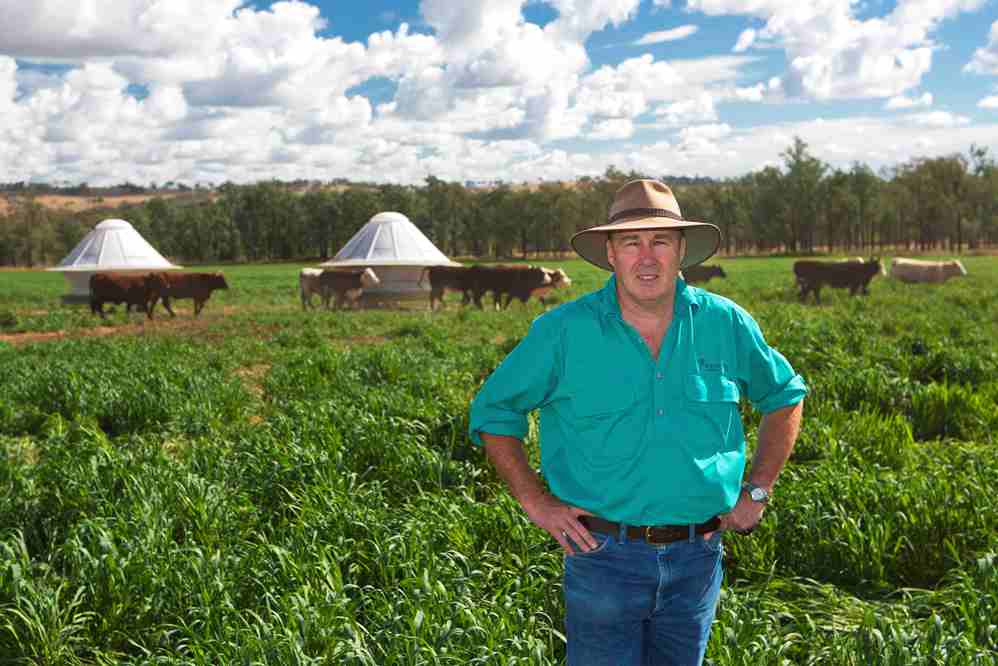
Ceres Ag’s Mark Mason in one of the 300 pasture-based finishing cells at Gunyerwarildi, near Warialda.
Each paddock holds about 100 head of cattle with two self-feeders, which are replenished weekly.
The paddocks are sown to a mix of tropical pastures, including digitaria, bambatsi panic and purple pigeon grass, or feed oats, ensuring a ready supply of high quality pasture throughout the year.
Despite the relatively high grazing pressure, Mr Mason says the pastures are self-sustaining and require little maintenance.
“We are importing nutrients, not depleting them,” he says.
“We spread the feedlot waste over the pasture and cropping country, plus there is heavy load from the cattle in the paddock. We have not had to apply fertiliser since we’ve started.”
A similar system is utilised to finish up to 10,000 head on the company’s southern operations at Oberon, but using conventional dry-rolled grain and temperate pastures.
Cattle are turned off at 500–520kg liveweight and then contract slaughtered at Bindaree abattoir in Inverell, about 100km away.
Carcases are submitted for MSA grading and sold on a whole carcase basis to Woolworths and Aldi.
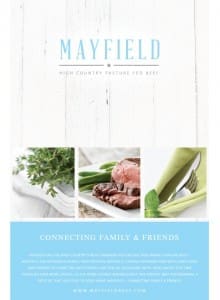 A small proportion is marketed under Bindaree’s Mayfield Beef brand, which has won gold and silver medals at the Brisbane, Sydney and Melbourne Food and Wine Shows.
A small proportion is marketed under Bindaree’s Mayfield Beef brand, which has won gold and silver medals at the Brisbane, Sydney and Melbourne Food and Wine Shows.
Mr Mason describes the introduction of the MSA beef grading system over the past decade as a ‘game changer.’
“The yardsticks of quality used to be what breed of cattle you had or how they were fed,” he said. “With MSA, it’s all about eating quality in the eyes of the consumer.
“We’re producing high quality ‘grain-assisted’ beef but under pasture-based conditions, which gives us a fairly strong competitive advantage on a number of levels. We don’t have an enormous capital investment of a large feedlot, yet we are achieving the same throughput.”
“The cattle are getting about a significant proportion of their daily intake from pastures, which means we are feeding considerably less grain. Each animal eats about 9 kg/day of our finishing ration in the paddock, as opposed to 15 kg/day in the feedlot.”
New cipher for “Grain-assisted” cattle programs?
Down the track, Ceres is hoping to work with AusMeat to develop a new standard that recognises what the company is producing – effectively, “Grain assisted” beef. While technically it’s not ‘grainfed’ (minimum 70 days confined feeding for steers on a ration of 10Mj or higher) but it’s not ‘grassfed’ either.
Every step of the chain is carefully monitored and managed to maximise productivity and efficiency, and ultimately profit.
“We are chasing maximum liveweight gain at the least cost, the same as any feedlot,” Mr Mason said. The program is aiming for liveweight gains of 1.7 to 1.8 kg/day over 100 days and a feed conversion efficiency of 5.5 to 6:1.
With the feedlot and feedmill now fully operational, Ceres is about to hit top gear.
“The next five years is going to be about developing our brand, refining our processes and then increasing in size,” Mr Mason said.
“Ultimately, we want to get our throughput to 160,000 head, which will mean increasing the feedlot and feedmill capacity to match.
“The mill is currently only running for eight hours a day, and we have the ability to put in a third mill, so we could technically double or quadruple production if the opportunity presents itself.”
About half of the feedlot’s grain requirements is sourced from the 15,000ha annual cropping program on the company’s Moree and Warialda aggregations.
“The core focus of our cropping operation is to grow high value grain, such as prime wheat, durum wheat, malt barley, chickpeas, canola and sunflowers, but feed barley, sorghum and maize are also part of the rotation,” Mr Mason said.
Big reliance in efficient machinery
The operation includes a fleet of high performance Claas machinery, including four Lexion 740 combine harvesters and four Axion 900 series advanced technology tractors.
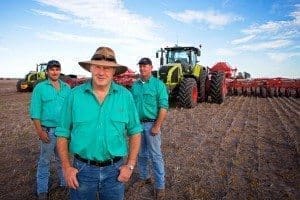
Ceres Ag MD Mark Mason (middle), with cropping manager, Ben Hurley and northern GM James Walker, with two Claas Axion 950 advanced technology tractors towing Morris airseeders.
“Initially, it was about sourcing machinery that improved our efficiency and could be moved easily between our Moree and Warialda operations, but now service is just as important as the machines themselves,” Mr Mason said.
“A lot of what we do is time-critical and service is everything. A couple of hours or a day out of action can easily cost us tens of thousands of dollars.
“We have our own mechanics but we if need to call WJ’s in Moree, they’ll be there within the hour with the right parts.”
Who is Ceres Agriculture?
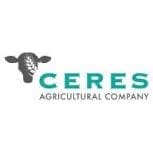 Ceres Agricultural Company is the brainchild of Managing Director, Mark Mason, and Sydney-based businessman, Garrick Hawkins, who have spent the past 16 years creating a large-scale integrated dryland cropping, beef finishing and wool growing business.
Ceres Agricultural Company is the brainchild of Managing Director, Mark Mason, and Sydney-based businessman, Garrick Hawkins, who have spent the past 16 years creating a large-scale integrated dryland cropping, beef finishing and wool growing business.
The company was formed in 2012 from the existing assets of Pegela Pastoral Holdings and capital from Singapore-based funds manager, Duxton Asset Management.
At the time, Pegela comprised Mayfield and Ballyroe at Oberon; Gunyerwarildi, Postmans, Brentwood, Lava Downs and Inverness at Warialda; and Brudle Park and Oaklands at Moree.
About 15 years ago, the predecessor company was running a fairly traditional grazing enterprise based at Oberon supplying backgrounded cattle to Rockdale feedlot. In 2000, it expanded into cropping and grazing in northern NSW but the operations remained fairly separate.
In some years, it was struggling to get cattle to background weights and in others, it was growing good crops, but getting poor returns.
“We decided to integrate the businesses into one and to maximise our value-add from start to finish,” Mark Mason said.
“We didn’t set out to create something this big, but it quickly became obvious how big this needed to be to make the numbers work.”
“Duxton saw the potential of our model and decided to back us.”
Duxton Asset Management specialises in creating large, integrated agricultural units capable of achieving high levels of operational efficiency via the use of technology, best management practices and environmental sustainability.
Ceres Agriculture today employs more than 100 people across its northern and southern operations. Key staff include including Northern general manager, James Walker; Southern general manager, Stuart McDonald; and quality assurance Manager, Troy Fitzpatrick.
Mark Mason, a sixth-generation farmer originally from Wellington in NSW, is justifiably proud of the success of the venture to date.
“It was never about the size of what it’s become but the genuine passion to do something that has not been done on this scale before,” he says.
“We’ve had our share of setbacks and knockers but my mother always said, ‘There’s no such word as can’t.”

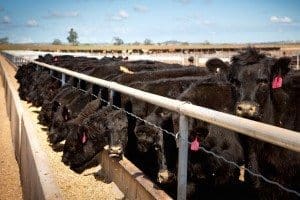
My late brother John was doing this from the early 1900 and selling grain assisted organic cattle with great success,and getting a premium and a desired carcase the buyers wanted..no hormones or growth promotants used. Mayne family, Springsure, Central Queensland.
This is certainly looking to the future along with the best use of paddock and grain use love to see more